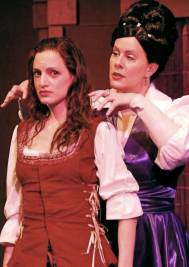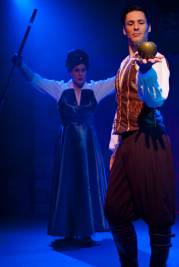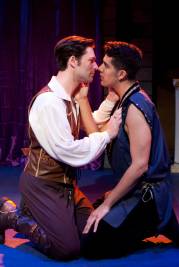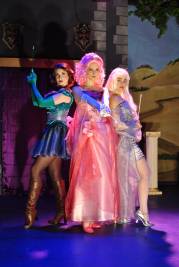
If there were a book titled Everything I’ve Learned In Life, I’ve Learned From Fairy Tales, then what lessons could a pintsized LGBT-in-training gain from it? That Cinderella found her Prince? That a Prince awoke Sleeping Beauty with a kiss? That a kiss turned a Princess’s frog into a handsome Prince? Where’s a little boy or girl to look for fairytale inspiration when what they’re secretly dreaming of is a Prince for him, and a Princess for her?
The answer is at long last found in Brian Pugach’s charming new musical The Next Fairy Tale, now getting its World Premiere Production at Celebration Theatre under the deft direction of Celebration Artistic Director Michael A. Shepperd.
Pugach, who began writing music, book, and lyrics for The Next Fairy Tale while a UCLA theater major a few years back, has created a magical, mythical world where “Every Hundred Years” a group of Fairy Godmothers and their Fairy Godmistress leader Minerva meet to bring to life a new fairy tale. Ten decades ago, it was the tale of Red Riding Hood, an unlucky lass who ended up (along with her ill-fated Granny) eaten up by a hungry wolf—all this misfortune due to the late arrival of that Centennial’s Godmother, the ever hapless Hazelnut, aka Hazel.
To learn just who the hero or heroine of The Next Fairy Tale will be, Minerva consults (who else?) her Magic Mirror, who sends her off to the land of Lumeria, where handsome Prince Copernicus fights evil, not with a sword, but with “kindness, smiles, and hugs,” a creed he reminds others of by handing out Kindness Cards, “a reminder to be kinder.”
If Minerva is a bit unsettled to learn this decidedly unvaliant method of combat, she is even more disturbed when Prince Copernicus informs her that the distressed soul he has vowed to rescue from a dragon-guarded tower and a wicked, disapproving stepmother is none other than the handsomest prince in all the land, Prince Helio of Stortelia. Though Copernicus professes his true love for Helio in “Charming” (“He’s not a muscular manly he. His tiny sword is not much to see. He’s charming and that’s enough for me.”), Minerva is not at all convinced, responding, “‘He’s charming!’ or so he said; I’ve been nauseous ever since. Alarming! A hero rescues a princess, not a prince!”
And so, in a tradition upheld from the time of the fairies to contemporary evil bitc…, sorry evil witches like Maggie Gallagher, Minerva sets out to destroy any possibility of a happy ending for Princes Copernicus and Helio, certain that the assignment of bungling Hazel as this Centennial’s Fairy Godmother will make her task child’s play.
On their way to Stortelia, Copernicus and Hazel stop off in the village of Avaricia, whose residents (Rumpelstilstkin, Little Red, Baker, and Geppetto) conspire to prevent the Prince from stealing the sword in the stone he’ll need to slay the dragon and rescue Prince Helio.
Believing with all her twisted heart that “saying two princes can have true love is a lie,” Minerva concludes that a mere attempt to thwart Copernicus’s quest will never be enough to prevent the destruction of traditional family values and, in Act One’s finale, persuades the Prince to “Take The Apple” … and die!
Fortunately for the star-crossed princes, The Next Fairy Tale has a second act up its sleeve.
Pugach knows his fairytale lore backwards and forwards, creating a world in which characters have names like Thistle, Moonflower, and Hazelnuts and speak in Fairytalese, whether uttering exclamations (“Oh toadstools!” “Jumping gingerbread!” “Candy covered cottages, I can’t move!”) or inventing similes (“You are slower than toad slime.” “You are as selfish as a stepsister.” “I’m as serious as a wolf attack.”) As Stephen Sondheim and James Lapine did in Into The Woods, he also knows how to mix-and-match fairytale characters to nifty effect. As for his songs, several in particular you may find yourself humming as you leave the theater—Copernicus’s delightfully self-centered “Charming,” Minerva’s ominously dramatic “Take The Apple,” and Copernicus’s and Hazel’s oh-so-romantic “Cinderella Story,” which (like “Charming”) merits—and gets—a reprise.
Still, as with any World Premiere Musical, there is room for tweaking. The addition of a greater number of adult-aimed jokes, the kind which Disney perfected in the 1990s, lines which whoosh over the heads of tots but give the piece the sophisticated all-age appeal of Disney’s Beauty And The Beast, would make the show more grownups-friendly. The Next Fairy Tale has some terrific ones (“You must be a friend of Dorothy!” “I’d hate for you to end up a flamer.” “Key change.”) but could use even more. Additional stage time for Prince Helio in Act One would help us become more invested in our heroes’ romance from the get-go. At the same time, judicious cuts (including perhaps a couple of Act One songs by minor characters) would bring The Next Fairy Tale in at a more kids-friendly two-hour running time, and get us more quickly to its powerful second act. Also, as fine as musical director Wayne Moore’s work is, Pugach’s songs would sound considerably better with a richer accompaniment than the rather tinny-sounding upright piano they get here, though Adam Halitzka’s percussion does help.
Pugach and the Celebration have lucked out big time in the cast Jami Rudofsky has helped them assemble for this World Premiere, beginning with the trio of performers who bring to vivid storybook life its biggest roles—Christopher Maikish as Prince Copernicus, Rachel Genevieve as Hazel, and Gina Torrecilla as Minerva. Maikish and Genevieve have been waiting for that perfect part to best showcase their talents, and Pugach has written them just those parts. Maikish’s dreamy good looks, rich tenor, romantic sparkle, and comic zip make him the perfect Prince Charming. Genevieve’s combination of dark-haired beauty, charismatic stage presence, gawky charm, and downright adorability combined with her glorious soprano simply couldn’t be more right for Hazel. As for Minerva, Torrecilla expertly channels every fairytale villainess (particularly Snow White’s evil stepmother and Cinderella’s Maleficent) with touches of today’s NOM demonesses to make for an imposing figure of “family values” gone berserk.
Handsome, golden-voiced Patrick Gomez is a Prince any Prince could fall for at the wave of a wand, and doubles delightfully as a silver-haired mustachioed Geppetto. Hazel’s fellow Godmother’s are brought to quirky, scene-stealing life by three vivacious blends of beauty and comedic/vocal chops—Stephanie Fredricks as Thistle, Kendra Munger as Glinda, and Nell Teare as Moonflower, with Fredricks a delicious Cinderella and feisty Baker and Teare a spunky Little Red to boot. Vash Boddie is another charmer as Scarecrow and Ben Caron delights as Rumpelstilstkin. Completing the cast is Charls Segwick Hall, the epitome of fabulousness as the Mirror (and the voice of the Dragon).
Music director Moore gets bonus points for his excellent vocal arrangements. Jeffrey Polk has choreographed some lively dance sequences, Victoria Profitt’s set design has just the right classic fairytale look and is lit dazzlingly by Matthew Brian Denman, and Raffel Sarabia’s costumes are a highly imaginative visual treat. Thumbs up go too to Martin Carillo’s sound design, Ronn Jones’ hair and wigs, and Michael O’Hara’s properties. A number of expertly executed slight-of-hand tricks have been coached by magic consultant Joyce Basche, “Ms,gician. John F. Wilson is music consultant and Tijuana Gray assistant choreographer.
The Next Fairy Tale is produced by John Michael Beck, with Ryan Bergmann, Cameron Faber, Parnell Damone Marcano, and Pugach as associate producers. Shepperd and Michael C. Kricfalusi are executive producers. Kevin Wisney is production stage managers and Paul Doble assistant stage manager.
With minor script revisions to give it more adult appeal and judicious cuts to make for a more kids-appropriate running time, The Next Fairy Tale could easily become an LGBT and (progressive) family theater favorite. Children will respond to its engaging storyline and cast of characters, adults will go for the romance, and grown-up gays will find The Next Fairy Tale an enriching and even cathartic experience. Here’s hoping that its near-universal appeal will attract audiences beyond Celebration regulars to Brian Pugach’s at-last-told tale.
Celebration Theatre, 7051B Santa Monica Blvd., Hollywood.
www.celebrationtheatre.com
–Steven Stanley
March 11, 2011
Photos: Matthew Brian Denman, except top left Ronn Jones






 Since 2007, Steven Stanley's StageSceneLA.com has spotlighted the best in Southern California theater via reviews, interviews, and its annual StageSceneLA Scenies.
Since 2007, Steven Stanley's StageSceneLA.com has spotlighted the best in Southern California theater via reviews, interviews, and its annual StageSceneLA Scenies.







 COPYRIGHT 2024 STEVEN STANLEY :: DESIGN BY
COPYRIGHT 2024 STEVEN STANLEY :: DESIGN BY